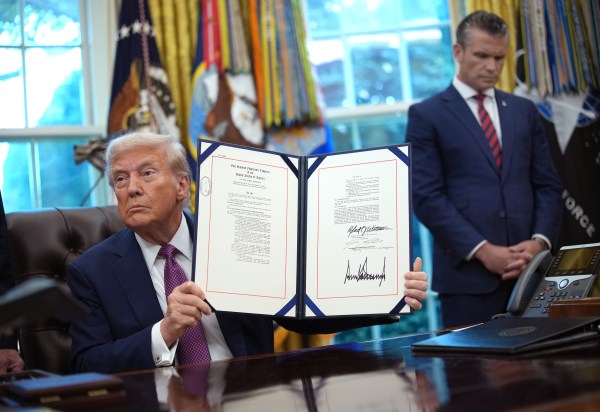The political analyst Samuel Lubell introduced the concept of the sun and moon parties in 1951. The sun party is the majority party, and “it is within the majority party that the issues of any particular period are fought out; while the minority party shines in reflected radiance of the heat thus generated.”
Franklin D. Roosevelt’s Democratic Party was the sun party for two generations, until the dawn of the Reagan majority. When Bill Clinton signed welfare reform and (falsely) declared, “The era of big government is over,” he was reflecting the reality of that transformation.
In the early 2000s, the GOP receded back into moon status. “But,” as David Brooks noted in 2011, “something strange happened. No party took the lead. … Both parties have become minority parties simultaneously. We are living in the era of two moons and no sun.”
That dynamic only intensified as politicians and voters accepted the new abnormal as normal. If you look too closely at specific elections, it can be hard to see, but the trend becomes clear in retrospect.
George W. Bush ran in 2000 as a sun party candidate and eked out the slimmest of victories. As it happens, the use of “red” and “blue” to denote Republicans, Democrats and the states’ political complexions also became a fixture of our politics that year. It may seem like a trivial thing, but I think red-versus-blue rhetoric accelerated polarization by solidifying the idea that partisanship is a kind of identity.
Bush won reelection in 2004 by leaning into the two-moon system, boosting turnout among his political base by emphasizing culture war issues, chief among them gay marriage and the impulse to support a wartime president.
Barack Obama’s election in 2008 obscured all of this because of the unique nature of his candidacy and Bush’s unpopularity amid a financial crisis and war weariness. But it’s worth recalling that as a candidate, Obama never pivoted to the center. He won reelection in 2012 with a brilliant base-turnout strategy, motivating millions of low-propensity young and minority voters.
In 2016, the Donald Trump-led GOP adopted the same strategy in reverse, turning out millions of low-propensity white, non-college-educated voters.
One result of this dynamic is that the parties increasingly don’t mind offending or infuriating those they consider irrelevant “enemy” voters. Indeed, outraging the opposition becomes a strategic goal because in an era of polarization, the enemy’s outrage bolsters partisan commitment (and donations) on your own side. This requires ever more apocalyptic rhetoric about the consequences of defeat.
More important, what happens in campaigns doesn’t stay there. Electoral strategies become governing philosophies. Parties that run on the theory that they only need more of the base to win become beholden to those core supporters in office.
At least rhetorically and stylistically, Trump’s administration was defined by his constant pandering to his biggest fans. Enraging his opponents was the essence of his presidency.
In 2020, Joe Biden ran as a throwback sun party candidate. He had his base supporters locked in because of their intense hatred for Trump. But his margin of victory came from voters who were nostalgic for normalcy.
Alas, once elected, Biden took that normalcy-craving middle for granted and outsourced policy to his base, believing he could be a transformative president rather than the caretaker he had implicitly promised to be. As moderate Democratic Rep. Abigail Spanberger of Virginia exasperatedly put it, “Nobody elected him to be FDR; they elected him to be normal and stop the chaos.”
Draw back the telescope, and you can see how two moons wreak havoc on the political tides. Each party floods into power in a state of simultaneous overconfidence in its policy mandate and panic that its hold on power will be short-lived. So they go for broke in placating the base and infuriating the opposition, making their fear of losing the next election a self-fulfilling prophecy. That’s why the White House and Congress keep changing hands, a rare event in the old sun-moon system.
One reason this unprecedentedly tied race is so difficult to handicap is that Kamala Harris and Donald Trump are scrounging for votes in different universes. Harris is repeating Biden’s strategy of trying to grab disaffected voters in the middle. Her problem is that until five minutes ago, she was widely regarded as aligned with the hardcore Democratic base; Biden at least seemed like a moderate Democrat.
Trump, meanwhile, couldn’t care less about the voters who dislike him and his antics. He’s aiming for the people who just want more cowbell.
Regardless of who wins, it’s clear that we won’t be seeing the sun for a while.







Please note that we at The Dispatch hold ourselves, our work, and our commenters to a higher standard than other places on the internet. We welcome comments that foster genuine debate or discussion—including comments critical of us or our work—but responses that include ad hominem attacks on fellow Dispatch members or are intended to stoke fear and anger may be moderated.
With your membership, you only have the ability to comment on The Morning Dispatch articles. Consider upgrading to join the conversation everywhere.